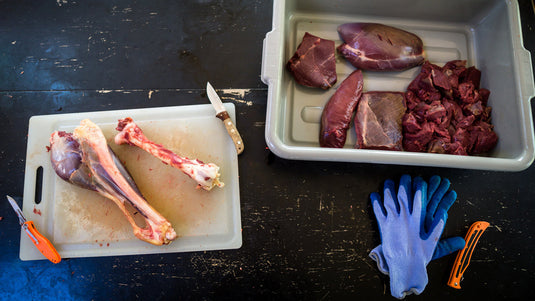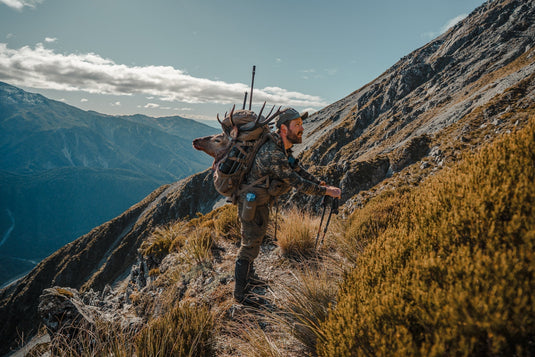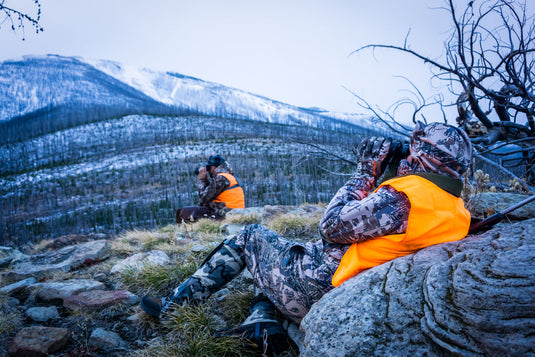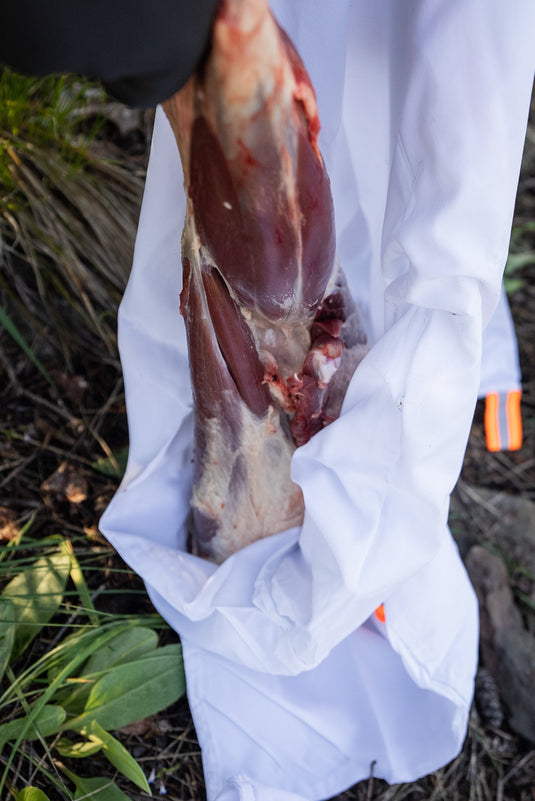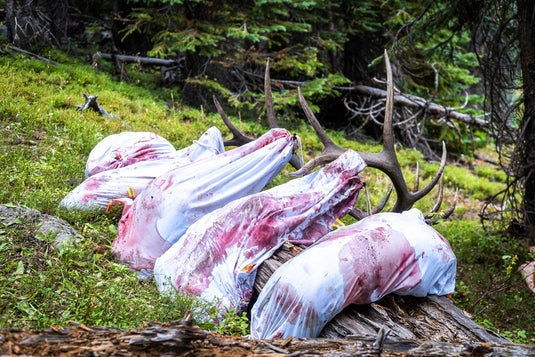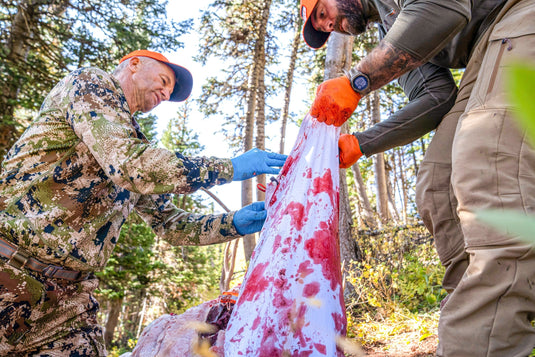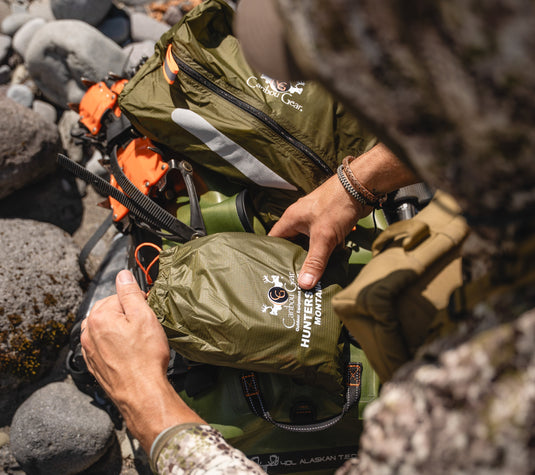The first article in this series was focused on layering for an early-season hunt. We outlined our typical clothing systems for the warm days and crisp nights that are so common in September in the mountains. In case you missed it, you can go back and read that one here. In this installment, we’ll offer a few mid-season layering tips. Next, be sure to look at Part 3: Late Season Layering Tips.
Mid-season layering is arguably the most difficult to pin down for any western big game hunt. Wild temperature swings are possible. And the weather can be extremely unpredictable. Sure, September can be finicky too. As we mentioned in the previous article, those early season hunts can deliver hot temps, snow or anything in between. But September snows usually melt within a day or two. Generally speaking, a good clothing setup can be pretty lightweight.
On the other end of the spectrum, late-season hunts into November and beyond are also fairly predictable. It’s probably going to be cold and your clothing system can easily be equipped to handle it. Thermal base layers, insulating mid-layers and heavy-duty outerwear is the name of the game during those late season hunts. We’ll cover that more in-depth in our next article.
Meanwhile, the month of October throughout the west can be a conundrum. There’s still a potential for very warm weather. We’ve spent plenty of October days walking over a golden carpet of fallen aspen leaves with a blazing sun in the sky. On the other side of the coin, October also has the potential to deliver sub-zero temperatures and deep snow in the high country. How do you efficiently prepare for both?
There’s not one right answer. There are many ways to build an effective mid-season layering kit. Have your own tips? Please leave them in the comments below! Here’s how we like to approach mid-season layering…
Prepare to Make Adjustments on the Fly
The hardest part to building a mid-season layering system is having enough to keep you comfortable in highly variable conditions, without making your daypack so heavy that it slows you down. There are a couple things you can do to make sure that doesn’t happen.
Plan A and Plan B Options
First, create a “Plan A” layering system for mild weather and “Plan B” layering system for very cold weather. If you’re hunting from your vehicle at a base camp, you can easily bring both systems. You can then re-pack your daypack and re-adjust your system as necessary throughout the week. This way, you avoid carrying more than necessary in your daypack.
If you are planning a backpack hunt, go ahead and pack both systems in the vehicle. Based on the forecast when you hit the trailhead, you can decide which system to bring. If needed, you can always return to your vehicle during the week to re-adjust.
Watch The Forecast
When you are within about a week of your hunt, keep a careful watch on the forecast. By the time your hunt is a day or two away, you should have a decent idea of what the weather will be like.
It probably goes without saying that a mountain forecast is never very accurate. Always treat any forecast with a high level of variability. Don’t take it for more than it’s worth. However, this will at least give you a ballpark idea of what you might be dealing with. Additionally, I will check the forecast daily on my Garmin InReach device (assuming I don’t have cell service). If a forecasted storm dissipates, or if a new storm arises, this will usually give me at least 24 hours notice. This makes it pretty easy to make adjustments throughout the week.

Building Your System
Pack Mid-Weight Base Layers
On almost all of my mid-season hunts, I like to pack a mid-weight base layer. This will get me through almost any conditions I face.
Whereas those early season hunts require a lightweight set of base layers for hot afternoons, I almost always need something more substantial in October. Yet most of the time, there’s really no need for a set of heavy, thermal long johns. If the forecast looks like it’s going to be extremely cold, you could of course change your mind and call an audible at the last minute. But with the right insulating mid-layers, a standard mid-weight top and bottom should work just fine.
Materials for your base layers should be high quality synthetics or merino wool.
Mid-Layers: Vest, Jacket & Puffy
There are three primary pieces that comprise my mid layers in this system. The first is a mid-weight fleece or soft shell vest. Worn directly over my base layer top, this provides a great deal of core warmth in a very small package. I like fleece because it’s breathable for active hunting. But a soft shell face fabric is nice for blocking wind if the weather is cold.
Next, I’ll add a mid-weight jacket. This might be a synthetic fleece, merino wool or even a softshell depending on conditions. I prefer fleece or merino, as they are lightweight, breathable and versatile. Breathability is better for active hunting so that you don’t build up a sweat and subsequently get cold. But when conditions are more severe, something with a soft shell face does have its benefits. That might be the answer in your “Plan B” system for very cold weather.
Finally, your mid-layers aren’t complete without a puffy jacket for ultimate lightweight insulation. There are plenty of great synthetic and goose down options for hunters. Personally, I prefer high quality goose down. No synthetic material can compare to quality down for its warmth-to-weight ratio. A very high quality down like 800-fill also packs down extremely small, taking up very little space in your daypack.

Outerwear: Waterproof, Breathable Rain Gear
High quality rain gear is absolutely essential on mid-season hunting trips. Even when the weather is dry, I never leave camp without it. That’s because a rain shell is useful for more than just rain. These hard shells are also windproof. In fact, did you know that a garment labeled as Gore-Tex rain gear and one labeled as Windstopper both have a waterproof breathable membrane? The only difference, is that rain gear has taped seams. For that reason, I rarely pack a separate Windstopper jacket on western hunts.
Mid-season hunting usually means a lot of glassing. Picture the situation: first thing in the morning, you climb to your glassing point before daylight. You want to be there, set up behind your binos as soon as it’s light enough to see. Climbing up to that glassing point in the dark requires some level of exertion. For that reason, a breathable jacket like we mentioned above is important. You don’t want to get sweaty right before you sit down in the cold. As soon as you sit to begin glassing, throw on your puffy jacket and your rain shells (top and bottoms). Now, you can sit much more comfortably for a much longer period of time.
If the weather does become wet or snowy, you might end up wearing your rain gear all day long. We’ve certainly had some late October hunts when rain gear became a permanent thing. Along with your rain gear, always pack a set of waterproof, breathable gaiters on mid-season hunts. Whether it’s wet brush or post-holing through snow, gaiters will help keep your socks and boots dry in even the nastiest conditions.
Extremities: Hats, Gloves, Socks and Boots
Don’t neglect those items that complete your mid-season layering kit from head to toe. A ball cap, a warm beanie and a neck gaiter are necessities. Plus, I usually pack at least two pairs of gloves – a mid-weight glove for mild conditions and a heavily insulated glove for very cold weather.
Finally, we can’t overstate the importance of high quality merino wool socks and a solid pair of mountain boots. Don’t even think about bringing cotton socks into the backcountry. We highly recommend Kenetrek boots and socks for their performance and durability.
Reach Out With Questions
Check out the rest of the camping and hunting gear we have in the Caribou Gear Store. The items we stock are the same ones we use and trust in the field. If you have questions or if we can help you find the right gear for your next adventure, please don’t hesitate to contact us. We’d love to help you feel prepared for your next western big game hunt!









